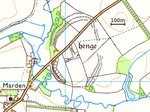Chirton
Civil parishes in WiltshireEngvarB from August 2019OpenDomesdayPages containing London Gazette template with parameter supp set to yVillages in Wiltshire

Chirton is a village and civil parish in Wiltshire, England, on the southern edge of the Vale of Pewsey about 5 miles (8 km) south-east of Devizes. The parish includes the hamlet of Conock, about half a mile west of Chirton village. Both settlements are just north the A342 Devizes-Andover road and are reached by separate lanes from the main road. The northern boundary of the parish follows approximately the course of the River Avon, and in the south the parish extends onto Salisbury Plain.
Excerpt from the Wikipedia article Chirton (License: CC BY-SA 3.0, Authors, Images).Chirton
The Street,
Geographical coordinates (GPS) Address Nearby Places Show on map
Geographical coordinates (GPS)
| Latitude | Longitude |
|---|---|
| N 51.317 ° | E -1.896 ° |
Address
The Street
The Street
SN10 3RN , Chirton
England, United Kingdom
Open on Google Maps










